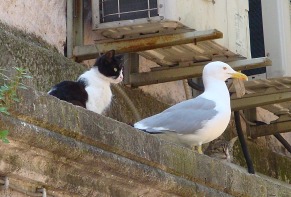Old names: Chrysopolis (City of Gold), Skoutarion, Scutari
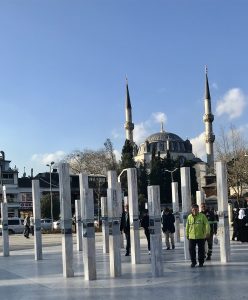
If you make only one side trip across the Bosphorus to the Asian side of İstanbul it should arguably be to Üsküdar, a suburb with a reputation for conservatism but which is full of fine mosques, including several by Sinan, as well as having a handful of decent places to meet. Its undercover market is also very colourful and worth a quick look (although the fruit and veg part of it was removed in 2014).
Just getting the vapur (ferry) across to Üsküdar is a delight offering the chance to eye up the cute little offshore Kızkulesi (Maiden’s Tower) as you glide into the pier. Its most recent restoration was completed in 2023.
Along the Coast Road
When you step ashore at Üsküdar you will be looking straight at the İskele Cami (Harbour Mosque) across the busy main road. The mosque is a work of Sinan dating back to 1548 and built for the daughter of Sultan Süleyman the Magnificent, Mihrimah Sultan. In some ways reminiscent of the Kılıç Ali Pasa Cami at Tophane, the İskele Cami once stood right on the waterfront before land was reclaimed in front of it to create the coast road.
Parts of the mosque complex still survive. The medrese, also overlooking the water, now provides an inviting centre for a clinic while the sibyan mektep (primary school) at the back now houses a children’s library. Unusually, there is a fine sundial attached to the mosque’s wall as you exit the courtyard towards the library at the rear.
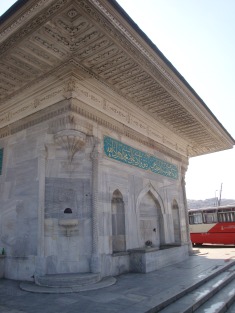 Stranded on a traffic island in front of the mosque is the lovely Sultan Ahmed III fountain which will remind many people of the one in front of the main entrance to Topkapı Palace. It was built in 1728 and its elaborate decoration includes verses penned by the sultan.
Stranded on a traffic island in front of the mosque is the lovely Sultan Ahmed III fountain which will remind many people of the one in front of the main entrance to Topkapı Palace. It was built in 1728 and its elaborate decoration includes verses penned by the sultan.
If you follow the coast road round towards the Maiden’s Tower you will reach the small Şemsi Paşa Cami, a complex that was designed by Mimar Sinan in 1580 for the Vizier Şemsi Paşa whose tomb opens, unusually, straight into the mosque. Covered in İznik tiles, it includes an epitaph written by Abdülcelil Levni (d.1732) that translates as “Hopefully the place of the blessed dead is paradise”.
Overlooking the point where the Bosphorus meets the Sea of Marmara, the building was nicknamed the “Birds Can’t Land Mosque (Kuşkonmaz Cami)” because the strength of the Bosphorus winds kept the seagulls at bay (although kuşkonmaz is also Turkish for asparagus). The mosque was restored in 2009; the medrese is now used as a library.
The coast road continues past Kızkulesi (Maiden’s Tower) just offshore. There appears to have been a tower on this spot since 408 BC when the first one was built by the Athenian general Alcibiades to ward off Persian invaders. In the 12th century the Byzantine Emperor Manuel I Komnenos built a small castle here which caught the eye of Sultan Mehmed II who refortified it in the 15th century. The castle eventually fell foul of a fire in 1719, only to be rebuilt almost at once by Damad İbrahim Paşa, grand vizier to Sultan Ahmed III. The tower that visitors see today only dates back to the early 19th century and the reign of Sultan Mahmud II.
In 2024 the Tower reopened to visitors (open daily, admission 27 euros, TL50 with müzekart) after a lengthy restoration.Whether you want to take the boat across to the tower may depend on time but in my opinion you won’t miss much if you don’t since the view from the tower is much the same as from the shore.
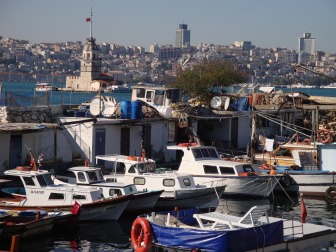 Beyond Kızkalesi lies a district called Salacak with a handful of fine old wooden yalis (waterside mansions) on the inland side of the road, Keep walking towards Kadıköy and you will reach a surprisingly rustic little fishing harbour still surviving in the heart of the city.
Beyond Kızkalesi lies a district called Salacak with a handful of fine old wooden yalis (waterside mansions) on the inland side of the road, Keep walking towards Kadıköy and you will reach a surprisingly rustic little fishing harbour still surviving in the heart of the city.
Heading inland
If instead of following the coast road you head inland from the ferry terminal you will see, on the right, the enormous Yeni Valide Cami which manages to inject a touch of greenery into a very built-up area. It was commissioned in 1710 for Sultan Ahmed III’s mother, Valide Rabia Gülnüş Ümmetullah and, unlike many of İstanbul’s later mosques, it was designed with a large courtyard surrounded with porticoes like the earlier imperial mosques. It makes a wonderfully quiet oasis from the traffic hustle outside.
If you leave the mosque through the exit on the water-facing side you will come to a lovely fountain and the twin-domed, restored Cedit Valide İmaret (Soup Kitchen). Just round the corner the lost wooden Balaban Tekkesi (dervish lodge) of the early 17th century was completely rebuilt in 2008.
Across busy Selmani Pak Caddesi stands a brick-built hamam apparently designed by Sinan between 1574 and 1583 for Nurbanu Sultan, the mother of Murad III. The income generated by it t was intended to support the costs of the Atık-ı Valide Cami, another work of Sinan further inland. Despite being the largest bath-house in Üskudar it had fallen into disrepair by 1917 and was then used as a warehouse and as a half-hearted shopping centre. When the main road was widened in 1959 part of the changing area was lost while a 1962 restoration added an annexe. In 1923 it reopened as a small gallery-cum-secondhand books market-cum-cafe on the edge of a new square featuring pillars with information on all the other Sinan buildings in İstanbul.
If you cut inland from the Şemsi Paşa Cami you will come to the pretty Rum Mehmed Paşa Cami, which, with its brick-built dome, has a vaguely Byzantine look to it. It was built in 1471 for one of Sultan Mehmed II’s grand viziers.
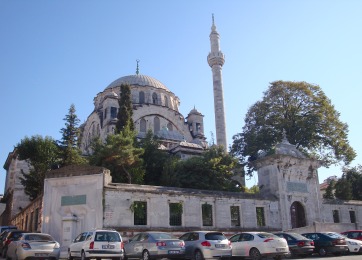 Ayazma CamiFurther inland and uphill from the Rum Mehmed Paşa Cami is the huge baroque Ayazma Cami, commissioned by Sultan Mustafa III for his mother Mihrişah Emine Sultan in 1760, and designed by Mehmed Tahir Ağa who reportedly used almost 9,000 eggs and plenty of honey to make the cement. The mosque is named after a neaby ayazma (sacred spring) as was a palace of which there is no longer any trace. Note the small birdhouses on the façade and on the gateway. Look out, too, for what are probably the last remaining Janissary tombstones in the city, identifiable from the flamboyant headgear carved onto the top of them. This is the mosque that dominates the eastern skyline of Üsküdar as you approach by ferry.
Ayazma CamiFurther inland and uphill from the Rum Mehmed Paşa Cami is the huge baroque Ayazma Cami, commissioned by Sultan Mustafa III for his mother Mihrişah Emine Sultan in 1760, and designed by Mehmed Tahir Ağa who reportedly used almost 9,000 eggs and plenty of honey to make the cement. The mosque is named after a neaby ayazma (sacred spring) as was a palace of which there is no longer any trace. Note the small birdhouses on the façade and on the gateway. Look out, too, for what are probably the last remaining Janissary tombstones in the city, identifiable from the flamboyant headgear carved onto the top of them. This is the mosque that dominates the eastern skyline of Üsküdar as you approach by ferry.
The creme de la creme of the Üsküdar mosques is the Atik Valide Cami, uphill along Dr Fahri Atabey Caddesi (formerly Toptaşı Caddesi) which is marked by a preserved cannonball. The hill is steep so you might prefer to jump in a bus and ask to be put out near the mosque complex. It goes almost without saying that this mosque – the Süleymaniye of the Asian side of İstanbul – is a work of Sinan dating back to 1583 when it was built for Sultan Selim II’s wife, Nurbanu Sultan.
The mosque itself, copiously decorated with İznik tiles, is perhaps smaller and lower than you might expect but the peaceful courtyard is a delight. More importantly, a lot of the complex still survives. The caravanserai belongs to Marmara University but has been allowed to fall into a shocking state of disrepair. The imaret (soup kitchen) has been repaired after long years of decay. Extraordinarily, the schoolhouse served for many years as a prison.
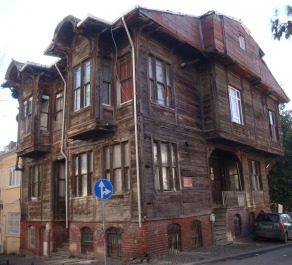 While up in this part of town you might want to look along the ridge of the hill in search of the enormous 19th-century Armenian Church of Surp Garabed, centrepiece of an attractive neighbourhood with some fine old wooden houses and the Greek Orthodox Church of the Profiti İlya and school close at hand.
While up in this part of town you might want to look along the ridge of the hill in search of the enormous 19th-century Armenian Church of Surp Garabed, centrepiece of an attractive neighbourhood with some fine old wooden houses and the Greek Orthodox Church of the Profiti İlya and school close at hand.
You might also want to look for the petite but lovely Çinili Cami (Tiled Mosque) and the hamam of the same name that is still in business for men and women. Built in 1640 for the powerful Mahpeyker Kösem Sultan, mother of sultans Murad IV and İbrahim the Mad, it is beautifully wallpapered with İznik tiles. Like the Rüstem Paşa Cami in Tahtakale it seems more truly worthy of the “Blue Mosque” nickname than the more famous Sultanahmet Cami.
One last more central mosque complex worth seeking out on Gündoğumu Caddesi is the Ahmediye Cami, added to the Üsküdar landscape during the reign of Sultan Ahmed III when it was built in 1722 for Eminzade Hacı Ahmed Paşa. The mosque itself is not especially dramatic architecturally but there is a fine sebil (water dispensary) attached to the wall outside, and the medrese (seminary) and kütüphane (library) still survive overlooking a garden courtyard.
The back streets of central Üsküdar behind the Yeni Valide Cami might not seem the most likely of places to find a museum displaying colourful kites from all around the world, but that is nonetheless where you’ll find the Uçartma Müzesi (Kite Museum, closed Sundays, admission free) spreading itself across two buildings, one of them devoted to displays, the other to kite-making workshops. If you still think kites have to take the form of flat diamonds, this is the place to come to learn otherwise. Indeed, it’s hard to imagine how some of the monsters in here would ever have found themselves airborne.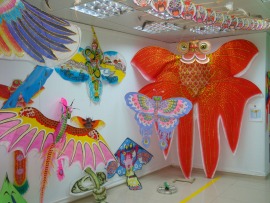
Walk along Doğancılar Caddesi to find the Şerefebad Kasrı Maksemi, a water distribution outlet similar to the better-known one near Taksim Square commissioned in 1728 by Damad İbrahim Paşa. On the way you’ll pass a pleasingly rural corner where the Sinan-designed İmrahor Cami (1597) is being rebuilt. Just past the maksem is the Doğancılar Çakırcı Hasan Paşa Cami, built originally in 1548 to a Sinan design but effectively rebuilt in 1858-59. Çakırcı Hasan Paşa – whose name suggests that he was blue-eyed – is buried in a tomb in the attractive graveyard.
The road leads ultimately to Doğancılar Park near where Hezarfen Ahmed Çelebi (1609-40) is supposed to have landed after flying from the top of the Galata Tower some time between 1630 and 1632 according to the travel writer Evliya Çelebi.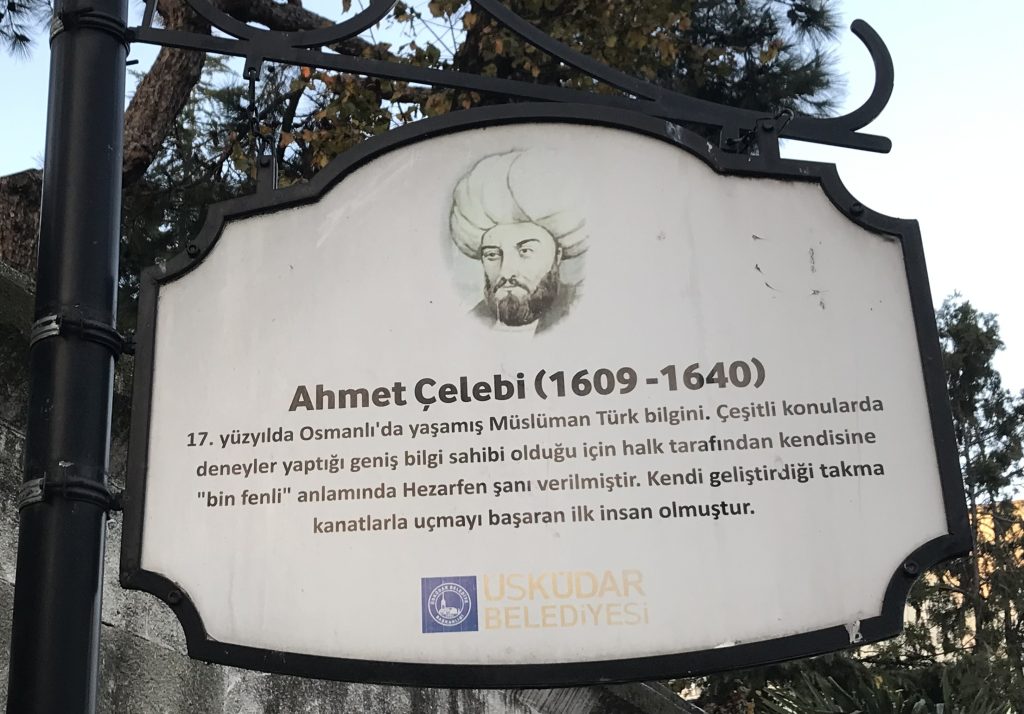
In the streets behind the covered market you might also stumble upon the cute little Hacı Şelim Ağa Kütüphanesi (library, 1782).
Graveyards
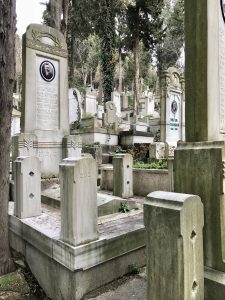
Üsküdar is home to the Bülbülderesi cemetery, last resting place of many Dönmes, Jews who converted to Islam and their descendants. Unusually in Turkey, their graves bear photographs of the deceased. It sits off Cumhuriyet Caddesi on Selankliler Sokak on the way to Fıstıkağacı.
Eating
Filizler Köftecisi Perfectly poised to grab the hungry commuters pouring out of the Marmaray, the Filizler is a multi-dimensional food centre with an indoor/outdoor köfte (meatball) restaurant right beside a pastry shop and small delicatessen.Ögdul Sokak No. 41, Salacak, Tel: 0532-298 0414
Kanaat (Wings) Something of an Üsküdar institution, Kanaat is a big, brightly lit lokanta that offers a tempting array of sulu yemeği dishes. It’s best visited at lunch-time. Selmani Pak Caddesi No. 25, Tel: 0216-341 5444
Nevmekan Sahil What was once Üsküdar’s wedding hall has been converted into a multi-purpose library, cafe and art gallery beneath a large dome. The food is hardly gourmet and there’s no alcohol but the prices are good and the ambience amiable. Şemsi Paşa Caddesi No 2, Tel: 0216-531 3000
Okyanus Fish Restaurant Cheerful small fish restaurant just in front of the market which I can rarely pass without siting down for a fish soup. Tel: 0216-638 3888
Transport info
Üsküdar is a major transport intersection for the Asian side of the Bosphorus. Regular ferries cross to Üsküdar from Eminönü, Kabataş, Karaköy and Beşiktaş as well as from Eyüp and points along the Golden Horn.
Üsküdar is the first station on the Marmaray train line after it emerges from under the Bosphorus heading from Sirkeci to Gebze.
Buses and minibuses head north along the coast road from in front of the İskele Cami. Those to Kadıköy wait in front of the Yeni Valide Cami. Dolmuşes also run east to the Harem Otogar for buses to Anatolia from here
Buses to Ağva and Şile on the Black Sea coast leave from near the Şemsi Paşa Cami.
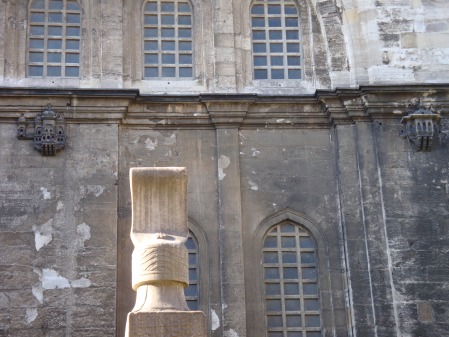 Ayazma Cami: Birdhouses and Janissary tombstones
Ayazma Cami: Birdhouses and Janissary tombstones
Nearby areas

